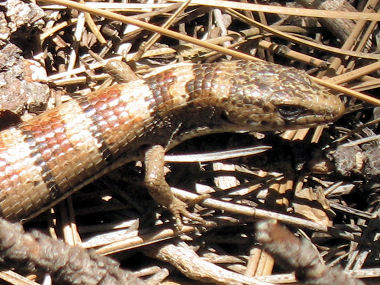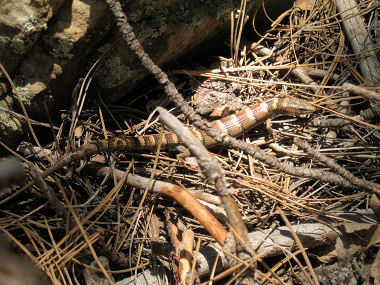Madrean Alligator Lizards are large (up to 5.5" from snout to
vent), smooth and shiny lizards with a long body, small limbs, and a long,
thick tail. Base coloration is usually tan or gray with a series of dark brown
to red-brown bands along their back. When not regenerated the tail is more than
twice the length of the body. The back and belly are armored with large, stiff,
rectangular, scales that are reinforced with bony plates. A soft fold of skin
covered with small rounded scales runs along each lower side of the body from
the corner of the mouth to the hind limbs. These folds of skin allow the body
to expand for breathing, ingesting prey, and egg development. Males have a broad head and distinct stripes. Adult
females are more pale in color. Juveniles are marked with distinct dark and
light bands on the body and tail, dark limbs, and white spots on the lips.
and egg development. Males have a broad head and distinct stripes. Adult
females are more pale in color. Juveniles are marked with distinct dark and
light bands on the body and tail, dark limbs, and white spots on the lips.
|
Madrean Alligator Lizards are capable of casting off (and
regenerating) their tails to thwart predators. |
Madrean Alligator Lizards are found throughout central Arizona's
Mogollon Rim country and south into the southeastern valleys and "sky island"
ranges. It is found at elevations ranging from 3,000 - 8,500 feet. The lizard
inhabits a variety of environments including semi-desert grasslands, chaparral,
woodlands, and pine forests. It is primarily active during the day, dawn and
dusk during the warmer months, hibernating in late fall and winter. It eats a
variety of insects including grasshoppers, caterpillars, moths and scorpions.
The lizard is thought to mate in September and October and produces a clutch of
up to 15 eggs in late spring or summer. Females may stay with the eggs to tend
to them.

|

